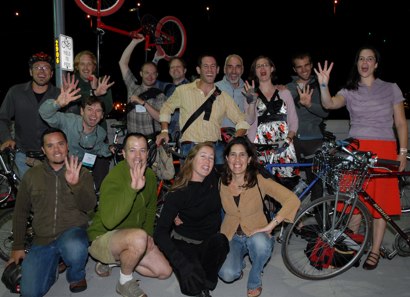Now that the whole country thinks Oregon isn’t in the top-three best states to bike in, you might assume the Beaver State delegation here at Pro Walk/Pro Bike would be sulking and demanding a recount.
Not exactly.
When the League of American Bicyclist’s executive director Andy Clarke announced the rankings at a party at the South Lake Union Armory last night, people almost immediately began embracing our new, out-of-medal-contention placing.
After the party, many of us from Oregon went on a spirited and star-lit ride around the city (via the Burke-Gilman Trail). I think the photo below will give you a good idea how we’re dealing with the No. 4 news:

Bottom (L to R): Denver Igarta, PDOT; Paul Adkins, GEARS (Eugene); April Bertelsen, PDOT; Mia Birk, Alta Planning. Middle (L to R): Shane Rhodes, City of Eugene; Scott Bricker, BTA; Michelle Poyourow, BTA. Back (L to R): Robert Ping, National Safe Routes to School Partnership, Carl Larson, BTA; Ian Stude, PSU; Roger Geller, PDOT; Jessica Roberts, Alta Planning; David Roth, City of Eugene.
Seriously though, since my story yesterday the League has posted their Bicycle Friendly State rankings press release online with more information (you can see the entire, 50-state list).
In that statement, League director Andy Clarke gives more reasons why Washington came out on top:
“Clarke points to Washington’s model bike laws, signed and mapped statewide bike route network, dedicated funding from the state for bicycle related programs and projects, and an active statewide bicycle advisory committee”
And here’s a bit more information on the top-ranked states as published in a story that appeared in the USA Today’s Travel section yesterday:
“Wisconsin has done a “great job” in designating trails, signage and itineraries, including creating a statewide cycling map that features farm-to-market routes. Arizona gets high marks for being among the first to enact laws protecting cyclists and backing them up with stiff penalties, a move that has encouraged other states to follow suit. Oregon has the highest number of bicycle-friendly communities, with 1% of state highway funds invested in accommodating cyclists [that’s a reference to the Oregon Bicycle Bill, created by Don Stathos].”
And now our friend Joseph Rose at the Oregonian has chimed in. A League spokesperson told Rose that,
“..the main thing that hurt Oregon was its discriminatory side path law.
“In Oregon,” she explained, “if there’s a path, bicyclists are required to take it” rather than staying on the roads with other traffic. “Bicycles are vehicles and have a right to be on the road as long as they follow the rules,” she said.”
Hmm. I’m not sure about that. Can anyone clarify all that? UPDATE: “Sidepaths” are synonymous with bike lanes. What she’s referring to is the Oregon law (814.420) that says essentially, that you must ride in the bike lane when/if it’s present. But what her statement fails to represent is that there is a host of exceptions to that law.
In fact, back in November of 2006, I reported on a court case (Expert witness backfires on DA in bike lane case) where PDOT’s bike coordinator Roger Geller was called as an expert witness on behalf of the DA in a prosecution of a cyclist for violating this very law. In the end, Geller’s testimony helped convince the judge that the defendant was not guilty for leaving the bike lane (to make a left turn in that instance).
To me, this illustrates a gray area with the League’s questionnaire. Does Oregon have a “mandatory sidepath law”? Yes, but it’s hardly set in stone and it’s certainly not as clear cut as the League spokesperson makes it out to be.
Either way, what’s done is done. I think this new program might end up having an even greater impact on bicycling than the League’s Bicycle Friendly Community program (the one that awarded Portland Platinum recently). The “X” factor with the Bike Friendly State program is that it will (hopefully) encourage more connections between non-profits, clubs, and agencies throughout the state. It will also (again, hopefully) shake up state departments of transportation, who are generally thought of as being a bit stodgy and slow to embrace non-motorized modes.
The exciting news is that we’ve got great community, political, and bureaucratic infrastructure in place here in Oregon — including several key people who I know will except nothing less that a #1 ranking come next year.

